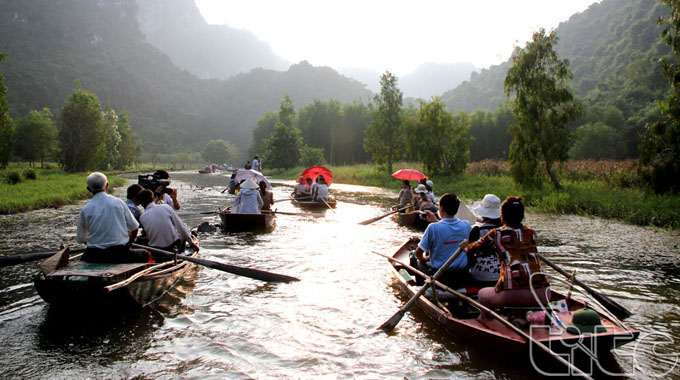Van Long Lake, situated in Gia Van Commune, Gia Vien District, Ninh Binh Province, is the largest wetland nature reserve in the northern delta region of Viet Nam. With a natural area of nearly 3,500 hectares, the lake is currently home to thousands of animals, plants and aquatic organisms, particularly the critically endangered Delacour langur (Trachypithecus delacouri) endemic to Viet Nam. This is an ideal destination for short-time travel for it is only 80 kilometres from Ha Noi, the capital of Viet Nam.
To reach the Van Long Wetland Nature Reserve, travellers need to follow National Road 1A to reach Gian Khau fork junction in Gia Vien District, Ninh Binh Province. Then, they will go further 10km to get to Van Long Lake. Boat is the most popular means of transport in Van Long Lake. While metal boats rest at marinas to wait for passengers in other tourist attractions in Ninh Binh Province like Tam Coc - Bich Dong or Trang An scenic landscape sites, the image of Van Long Wharf is quite different. Here, there are only small bamboo basket boats silently parking close together in the wharf and in the vast river to give a sense of countryside gentleness and peace to tourists. The basket boats move along creeks, surrounded by high-standing reeds and sedges, toward the foot of a mountain. The most beautiful scene in Van Long is seen in the summer time when lotus blossom along the way. Under the clear water lie algae and aquatic plants swaying to the rhythm of waving oars.

Van Long Lake is popularly called “No wave bay” because the water surface is as flat as a giant mirror. The clear water surface prints the mountain beneath. Van Long has 1,000 beautiful caves and many have tourism values, including Bong (Shadow) Cave, Ca (Fish) Cave and Rua (Turtle) Cave. The name of each cave has deep meaning relating to tales and legends associated with mountains like Ink-slab Mountain, Book Ark Mountain, Table Mountain and Cat Scratching Mountain.
A little further is Cua Chua (Pagoda Gate) Mountain where explorers and scientific researchers discovered murals with strange shapes on the cliffs, dated back hundreds of years. Mr Tran Xuan Quang, Director of the Management Board of Van Long Wetland Ecological Area, said, that Cua Chua Mountain has painting on the cliffs. It is blurred if we look at them in an ordinary way. But, it shows human figures and hieroglyphs when it gets wet. Mystery is gradually explored and explained by scientists and archaeologists.
Not only drawing visitors with its wonderful natural scenery, the Van Long Wetland Nature Reserve is also an ideal destination for lovers of natural discoveries. The scenic area which is larger than 3,000 ha is also the sanctuary and habitat of many animal and plant species, including endangered species listed in the Viet Nam Red Book and the World Red Book. Flora and fauna in Van Long are characterised by karst and wetland ecosystems in the Red River Delta. In Van Long, there are 39 animal species and 722 plant species. Among them, eight species are recorded in the Viet Nam Red Book, including king cobra, water monitor (Varanus salvator), python molurus, oriental ratsnake (Ptyas mucosa) and red-headed krait. There is also a bird sanctuary where there are 100 bird species. At sunset, flocks of birds and storks fly above the wetlands and rice fields to feed and portray a beautiful natural picture.
Especially, when exploring Van Long, every visitor always wants to watch Delacour langur swing on trees in the mountains. This is an endangered species listed in the Viet Nam Red Book and Van Long is home to the largest population of more than 40 Delacour's langur. Quang said Delacour langur is scientifically proven to have the largest population in Viet Nam. They can be watched on the mountains. Hoang Quyen Mountain has the largest group of Delacour langurs. We can see them sitting to eat or playing on mountain peaks in the afternoon or early morning.
Currently, Van Long is supported for the conservation of rare animal species by the Dutch Government, the Global Environment Facility (GEF) and the Cuc Phuong Endangered Primate Rescue Centre (EPRC). Every year, Van Long Wetland Nature Reserve welcomes a lot of international tourists, mostly tourists from Europe and South Korea, especially from May to September. Tourists not only have the opportunity to explore the pristine beauty of the water and the mountains of Ninh Binh, but can also record interesting discoveries on every cliff and in every cavern of this land.